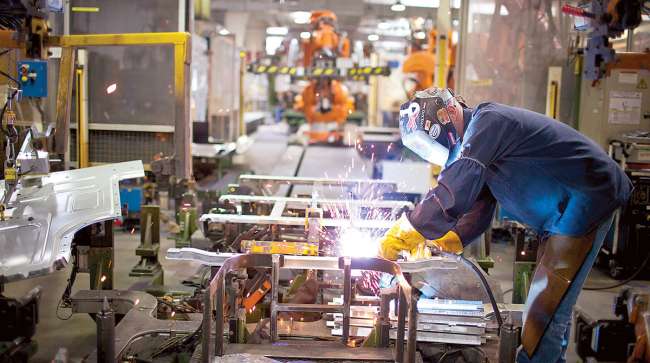Senior Reporter
September Class 8 Orders Erupt in All-Time Record

[Stay on top of transportation news: Get TTNews in your inbox.]
No need any longer to wonder about pent-up demand for Class 8 trucks, North American Class 8 orders in September surged past 53,000 to set an all-time high and nearly doubled those of a year earlier, ACT Research reported.
Orders were 53,700 compared with 27,155 a year earlier, according to ACT, citing truck makers’ preliminary data set to be finalized soon.
The previous record of 53,040 came in August 2018.
“Most, if not all, the truck makers have opened up the dealer order boards for 2023,” said ACT Vice President Steve Tam.
He said the orders show truck makers may now have improved visibility on the availability and prices of materials.

Tam
“It is possible, too, that the truck makers can’t hold back any longer and their customers are demanding the trucks. Prices can be negotiated depending on circumstances,” he said.
ACT reported the Class 8 order backlog for North America at the end of August was at 197,000, with only 8,000 of them slotted for delivery in the second quarter.
“So they, theoretically, could very easily deliver the whole [September order] in Q2,” Tam said. “They have the capability and capacity.”
But all the truck makers are telling their customers they will be on allocation for 2023, he added, as customers are asking for more than can be delivered.
Preliminary NA Class 8 net orders in September were 53,700 units, while NA Classes 5-7 net orders were 26,600 units.
Coverage from - @monitordailyhttps://t.co/7jx2rUsD1K#truck #semitruck #trucking #transportation, #Class8, #ACT, #ACTResearch — ACT Research (@actresearch) October 5, 2022
“Fleet confidence remains solid entering 2023, as many large national fleets are getting truck orders in as early as possible for next year’s deliveries,” Charles Roth, commercial vehicle analyst for FTR, commented.
FTR pegged preliminary September orders at 56,500 units.
Suppliers continue to face supply chain bottlenecks and labor shortages that impact build rates, FTR noted.
Roth suggested allocating production build slots could improve on-time delivery performance and reduce the impact of a component shortage.
“We have opened up order intake for Q1 and Q2. We are filling that at a good pace,” Jonathan Randall, senior vice president of sales at Mack Trucks, recently said. “The majority of what’s coming in is sold orders, customer orders. Mack usually works off of a premise that because our dealers sell a lot from inventory, usually we have 30% of our trucks in dealer inventory that don’t have customers names on them. Dealers are buying them for the walk-in business. Right now, that is at about 6% of dealer orders.”

Randall
He said the trucking industry seems to be “fairly resilient against the other general economic pressures, at this point.”
The distance between truck makers and their suppliers is narrowing, one industry expert said.
Outsourcing, which allows companies to reduce operating costs, was very popular for many years, said Rick Mihelic, director of emerging technologies at the North American Council for Freight Efficiency, as companies specialized in what they felt were their core competencies.
“That outsourcing created risks in the supply chain which we have seen evidence of in the last two years as multiple unexpected factors have combined to upset the stability of delivering products,” he said.
As a result, vertical integration seems to be “coming back in vogue,” he said. “Competition for emerging technologies is also part of this, trying to ensure your company has all the critical parts needed to stay competitive in commercial zero-emission and autonomous vehicles.”
Truck makers and major suppliers have acquired or partnered with companies that build axles, engine brakes, batteries, electric charging systems, sensors, software, electric motors, computer chips, connectors and harnesses, new fuel production, storage and more, Mihelic said.

Winter is coming. Bill Lindsay of Clean Harbors and Brian Antonellis of Fleet Advantage join host Mike Freeze to talk about winterizing fleets. Tune in above or by going to RoadSigns.ttnews.com.
“Another key investment we’ll see will be people, having the right technical capabilities in-house will see new hiring, and support for training investment at schools and universities related to all the new technologies,” he said.
Also, orders before long will be for trucks that meet more stringent emissions regulations, now nearing final form. Before that though, ACT has noted the possibility of a major pre-buy of Class 8 vehicles picking up in the second half of 2025 and then rising to a crescendo in 2026 ahead of new Environmental Protection Agency emissions regulations — proposed with two options — coming in 2027 to address greenhouse gases, particulates and nitrogen oxide levels, and warranty and durability issues.
ACT estimates meeting the 2027 regulation could add about $25,000 to the cost of a Class 8 tractor, Tam said, noting trucks today are about $185,000.
The price three years from now is uncertain.
Glen Kedzie, energy and environmental affairs counsel for American Trucking Associations, said, “I think the better time to be talking about this is come December when EPA puts out the final rule to see what discussions took place that we don’t know about between engine manufacturers and EPA staff. We will know in December what the stringency level of the EPA rule is. Don’t know now.”
Want more news? Listen to today's daily briefing below or go here for more info:

